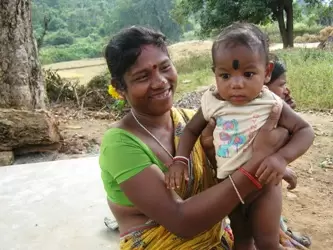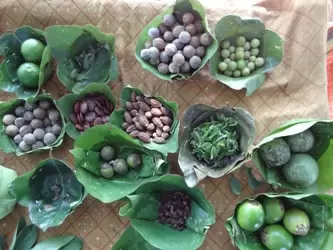Tribal women find empowerment in the food items they collect from forests

04-January-2014
Vol 5 | Issue 1
Ruke Pushika, 55, a tribal woman from Rayagada district in Odisha, goes out every day into the forest near her home in Bisam Cuttack block to gather fresh greens, fruits and tubers for her daughter, Tule, who is pregnant.
For a landless widow like Ruke, these ‘uncultivated foods’ are a real godsend – they cost her nothing and yet she knows she is providing the right nutrition not just to her daughter but to other members of her family as well.
 |
|
Hiramani Kadraka, 24, a new mother, is regularly including forest greens in her diet to regain her strength (Photos: Sarada LahangirWFS)
|
Both Ruke and Tule are well aware of the nutrients they derive from the forest produce they now consume regularly.
Says she, “Not only am I giving the leaves, fruits and millets I collect from the forest to my daughter, I make sure that I tell other pregnant women to eat well too in order to give birth to healthy babies.”
Traditionally, tribals in southern and western Odisha have relied on rain-fed agriculture and the forest to meet their livelihood and food needs.
Yet, as a practice, they only go into the forest when crops fail or when the local government run Public Distribution System fails to provide regular supplies. Such sustained food insecurity has led to rampant malnutrition and starvation deaths are known to occur here.
Hunger is a burning issue in Rayagada, a district with a tribal population of 57 per cent. So, when Living Farms, a Bhubaneswar-based non-governmental agency, started working there – presently it is implementing the Fight Hunger First Initiative (FHFI) project funded by Deutsche Welthungerhilfe (WHH) of Germany – it was confronted with a puzzling question.
When people had access to the forest, a ready source of foods that included fish and birds, why were the women and children, in particular, on the verge of starvation?
To gain a deeper insight into the health indicators and lifestyle patterns prevalent, they conducted an exhaustive survey of 52 villages in Bisam Cuttack and Muniguda blocks in 2011.
The findings were demoralising. Within a time frame of 12 months, 23 children below one year had died out of 171 live births reported. This roughly amounted to 131 deaths per 1000 live births, higher than the district Infant Mortality Rate (IMR) of 83/1000 live births and the state IMR of 69.
Twelve per cent of the sampled 693 children below five years were severely wasted; 75 per cent were stunted and, of those, 55 per cent were severely stunted. It was also revealed that the cycle of malnourishment started with the mother.
Of the 138 pregnant women surveyed, 13.8 per cent were malnourished with a Mid Upper Arm Circumference (MUAC) of less than 21 cm and it was these women who had a higher chance of giving birth to low birth-weight babies. Furthermore, 53 per cent of the mothers of children below two years were in the category of ‘under nutrition’ with a Body Mass Index of less than 18.5. It should be between 18.5 and 20.5.
“This study indicated high levels of malnutrition. When we sought the reasons behind it, we discovered that their daily meals mostly consisted of rice, dal, milk and oil.
“Green vegetables, meat, eggs and fruits were a part of their weekly or monthly diet – and only when they couldn’t afford grains. So, we decided to look into the significance of uncultivated foods in ensuring nutritional security for these families,” explains Debjit Sarangi, Founder and Director of Living Farms.
The first step was making a proper list of the forest foods and their nutritional values. Sarangi says, “With the help of trained nutritionists, 66 uncultivated foods (UCFs) were identified. Most of them were rich in a variety of nutrients, including folic acid, iron, calcium, vitamins C B and A, and beta carotene.”
Meanwhile, in villages across Bisam Cuttack block, activists went about gathering information on the seasonal dietary diversity of the tribals. Detailed discussions with the community revealed that UCFs constituted approximately 37 per cent, 29 per cent and 45 per cent of their total food basket during summer, monsoon and winter, respectively.
In fact, they named more than 60 different varieties of fruit (mango, wild cashew, black berry, jackfruit, kendu, date palm and mahua, among others), 40 kinds of leafy vegetables (barada saag, gandiri saag, chakunda saag, curry leaves, colocasia leaves and drumstick leaves, to name a few), 10 kinds of oil seeds, 30 kinds of mushrooms, roots and tubers, and 20 varieties of fish, crab, insects and birds that they could collect and consume directly from the forest.
Since UCFs were a rich source of nutrition, spreading awareness about their value was going to be the key. Nandika Singh, nutritionist from VSS Medical College, Burla, elaborates on the goodness of forest foods, “The edible wild leaves are an excellent source of vitamins A and C, protein as well as micronutrients like calcium and iron, which are commonly deficient in the diets of vulnerable communities.
“Similarly, forest fruits are good sources of minerals and vitamins and sometimes contribute significant quantities of calories. In this poverty-stricken district, it became clear that uncultivated foods can play a vital role in improving the nutritional status of the population.”
When Nidra Sikoka, 34, of Bangna village in Jagdalpur Gram Panchayat of Muniguda block, heard what the Living Farm activists had to say about UCFs, she was relieved to know that feeding her four children nutritious meals was not something she couldn’t afford to do.
 |
|
Forest fruits are good sources of minerals and vitamins and sometimes contribute significant quantities of calories
|
Says Nidra, “I have a small piece of land on which we grow paddy. Two years ago, because of erratic rains, our crop failed and we fell on very hard times. While my husband migrated to neighbouring Andhra Pradesh to work in a brick kiln, for me it was a struggle feeding my family.
“For a couple of months we survived on whatever I could forage from the forest, like different types of leaves, mushrooms and fruits. So when I heard the Living Farm activists talk about the benefits of these foods, I instantly realised that I did not need to spend money to give them good food. Now greens are a part of our daily diet.”
Hiramani Kadraka, 24, a new mother from Boriguda village in Bisam Cuttack block, too, is eating a balanced diet to regain her strength. She says, “I was severely anaemic when I was expecting and the ASHA didi told me that I needed to eat well.
“At that time my mother-in-law used to collect fruits, leaves from the forest and even harvested fish from available ponds. Once I started having these foods regularly my health improved and I had a normal delivery. My baby is also healthy. I have simply continued to include these fruits and vegetables in my meals.”
One of the more appealing activities through which Living Farms has reached out to the tribal women is by organising recipe festivals where they share seasonal preparations. Nutrition classes are in the offing as well.
“Additionally, we have been documenting the traditional knowledge of the tribals with regard to the harvest of each of the UCFs, their post harvest management, storage, preservation, cooking and consumption. We plan to prepare a policy paper for the state government so that it can advocate the promotion of UCFs as a way of fighting hunger,” states Sarangi.
Today, women like Ruke, Tule, Nidra and Hiramani have discovered a universe of nutrition that exists in the forests that surround them. Over time, many more should be following in their footsteps. - Women's Feature Service














